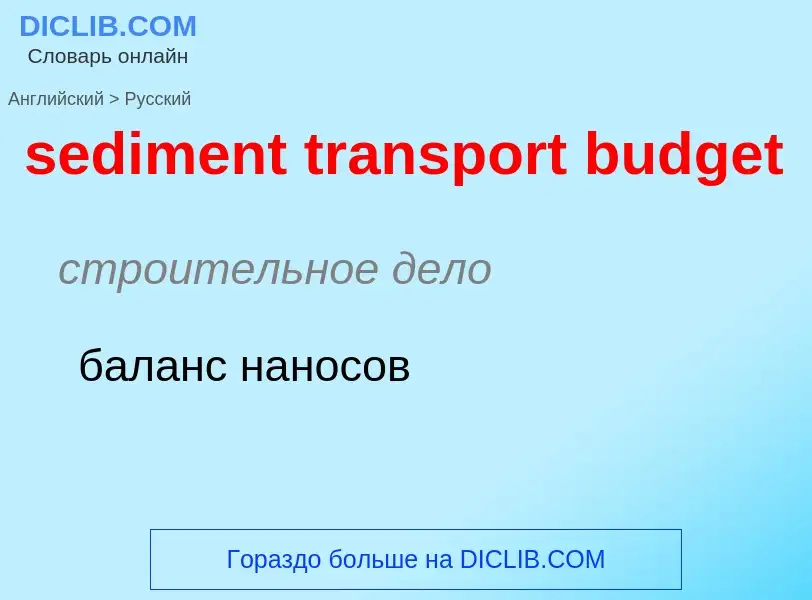Перевод и анализ слов искусственным интеллектом ChatGPT
На этой странице Вы можете получить подробный анализ слова или словосочетания, произведенный с помощью лучшей на сегодняшний день технологии искусственного интеллекта:
- как употребляется слово
- частота употребления
- используется оно чаще в устной или письменной речи
- варианты перевода слова
- примеры употребления (несколько фраз с переводом)
- этимология
sediment transport budget - перевод на русский
строительное дело
баланс наносов
['sedimənt]
общая лексика
осадок
отстой
нанос
отложение
отстойный
седиментационный
множественное число
наносы, отложения
нефтегазовая промышленность
осадок, отстой, гуща на дне
осадочная порода
вода и грязь из нефти
нефтяная эмульсия
осадочные отложения, наносы
Смотрите также
существительное
['sedimənt]
общая лексика
осадок
отстой
осадок, отстой
геология
отложение
осадочная порода
осадочная порода, отложение
глагол
общая лексика
осаждаться
отстаиваться
давать осадок
отстой
общая лексика
осадочная почва
нефтегазовая промышленность
слой осадочных пород
Определение
Процесс действия по знач. глаг.: закольцовывать.
Википедия

Sedimentary budgets are a coastal management tool used to analyze and describe the different sediment inputs (sources) and outputs (sinks) on the coasts, which is used to predict morphological change in any particular coastline over time. Within a coastal environment the rate of change of sediment is dependent on the amount of sediment brought into the system versus the amount of sediment that leaves the system. These inputs and outputs of sediment then equate to the total balance of the system and more than often reflect the amounts of erosion or accretion affecting the morphology of the coast.
To assess the sedimentary budget the coast has to be divided into two separate morphologies, commonly known as littoral cells and compartments. Sediment compartments can usually be defined as two rocky barriers which mark the ends of a beach and have a fixed sediment budget, although usually leaky to some extent. Littoral cells can either be free or fixed and can occupy a hierarchy of scales, from individual rip cells to entire beaches.
There are various types of natural sources and sinks within a coastal system. Sediment sources can include river transport, sea cliff erosion and longshore drift into an area. Sediment sinks can include longshore drift of sediment away from an area and sediment deposition into an estuary.
Anthropogenic activities can also influence sedimentary budgets; in particular damming of a river and in stream gravel mining of a river bed can reduce the sediment source to the coast. In contrast beach nourishment can increase sediment source.
In 1966, Bowen and Inman defined a littoral cell and separated sediment inputs, accretion by longshore drift and outputs.
Sedimentary budgets are used to assist in the management of beach erosion by trying to show the present sediment movement and forecast future sediment movement.


![Canterbury]], New Zealand produces 77% of sediment supplied to the [[Pegasus Bay]] coastline. Canterbury]], New Zealand produces 77% of sediment supplied to the [[Pegasus Bay]] coastline.](https://commons.wikimedia.org/wiki/Special:FilePath/Waimakariri02 gobeirne.jpg?width=200)



![Sediment in the [[Gulf of Mexico]] Sediment in the [[Gulf of Mexico]]](https://commons.wikimedia.org/wiki/Special:FilePath/Sediment in the Gulf of Mexico.jpg?width=200)
![Sediment off the [[Yucatán Peninsula]] Sediment off the [[Yucatán Peninsula]]](https://commons.wikimedia.org/wiki/Special:FilePath/Sediment off the Yucatan Peninsula.jpg?width=200)


![The financial crisis caused by the [[South Sea company]] led to the presentation of the government budget under Sir [[Robert Walpole]]. Painting by [[Edward Matthew Ward]]. The financial crisis caused by the [[South Sea company]] led to the presentation of the government budget under Sir [[Robert Walpole]]. Painting by [[Edward Matthew Ward]].](https://commons.wikimedia.org/wiki/Special:FilePath/South Sea Bubble.jpg?width=200)
